Evaluating HRM's Role: Workforce Planning at Marks & Spencer (M&S)
VerifiedAdded on 2020/10/22
|17
|5426
|272
Report
AI Summary
This report provides a comprehensive analysis of Human Resource Management (HRM) practices at Marks and Spencer (M&S), a British multinational retailer. It examines the purpose and functions of HRM in workforce planning and resourcing, highlighting strengths and weaknesses of different recruitment and selection approaches. The report also discusses the benefits of HRM practices for both employers and employees, emphasizing conflict resolution, training and development, employee relations, information provision, and motivation. Furthermore, it evaluates the effectiveness of HRM practices in raising organizational profits and productivity, including fostering innovation and high-performing employees. The importance of employee relations in HRM decision-making and the impact of employment legislation are also explored, along with the application of HRM practices in the workplace. Desklib offers similar solved assignments and resources for students.
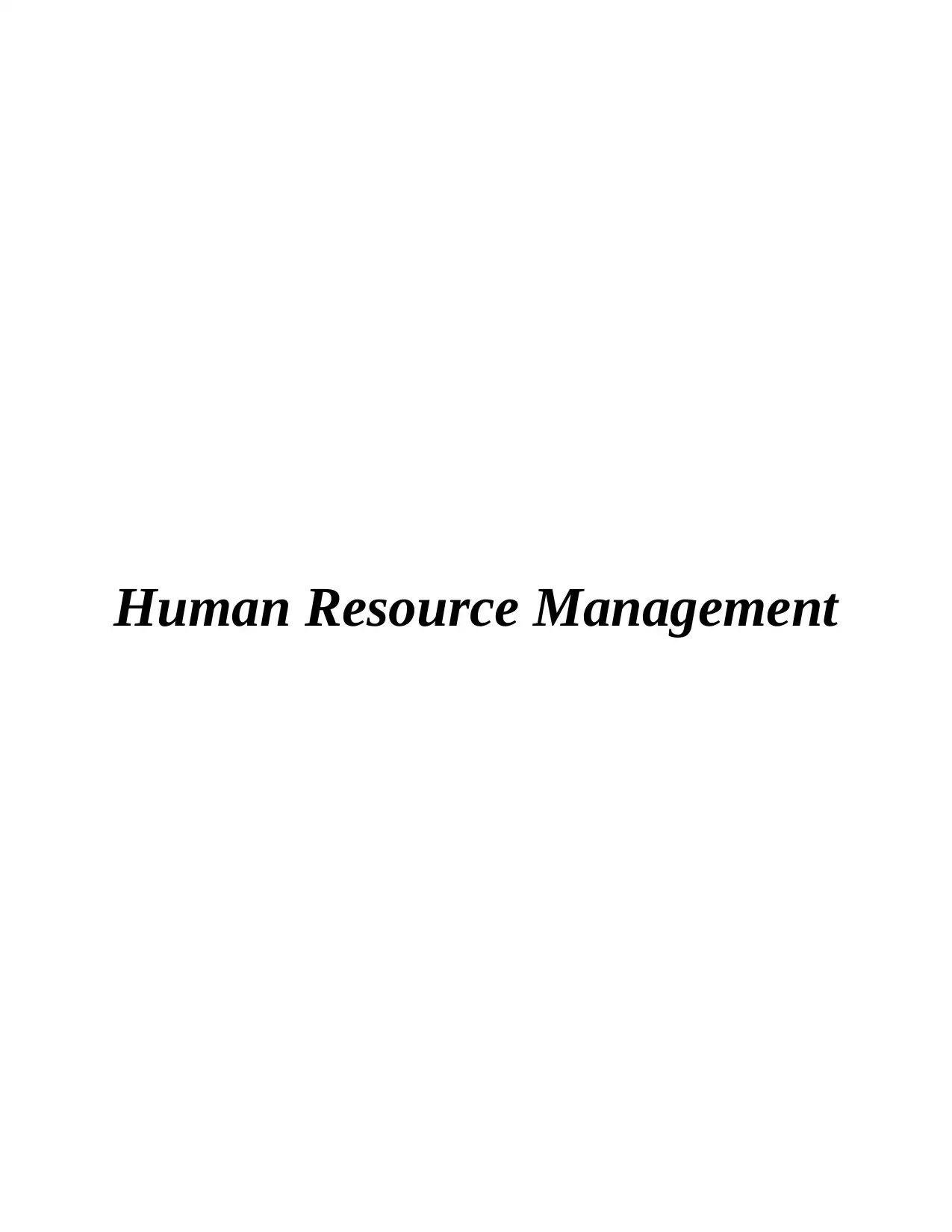
Human Resource Management
Paraphrase This Document
Need a fresh take? Get an instant paraphrase of this document with our AI Paraphraser
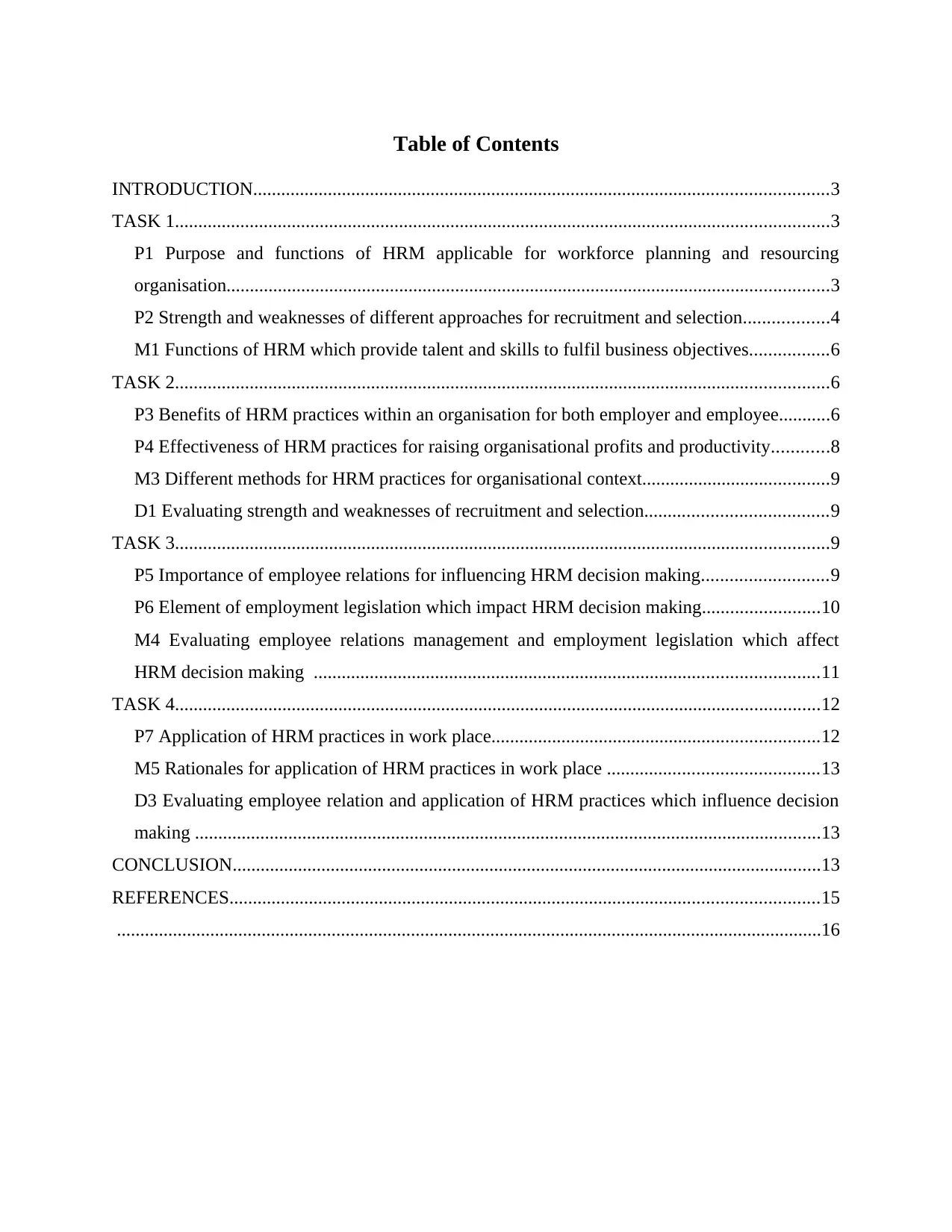
Table of Contents
INTRODUCTION...........................................................................................................................3
TASK 1............................................................................................................................................3
P1 Purpose and functions of HRM applicable for workforce planning and resourcing
organisation.................................................................................................................................3
P2 Strength and weaknesses of different approaches for recruitment and selection..................4
M1 Functions of HRM which provide talent and skills to fulfil business objectives.................6
TASK 2............................................................................................................................................6
P3 Benefits of HRM practices within an organisation for both employer and employee...........6
P4 Effectiveness of HRM practices for raising organisational profits and productivity............8
M3 Different methods for HRM practices for organisational context........................................9
D1 Evaluating strength and weaknesses of recruitment and selection.......................................9
TASK 3............................................................................................................................................9
P5 Importance of employee relations for influencing HRM decision making...........................9
P6 Element of employment legislation which impact HRM decision making.........................10
M4 Evaluating employee relations management and employment legislation which affect
HRM decision making ............................................................................................................11
TASK 4..........................................................................................................................................12
P7 Application of HRM practices in work place......................................................................12
M5 Rationales for application of HRM practices in work place .............................................13
D3 Evaluating employee relation and application of HRM practices which influence decision
making ......................................................................................................................................13
CONCLUSION..............................................................................................................................13
REFERENCES..............................................................................................................................15
.......................................................................................................................................................16
INTRODUCTION...........................................................................................................................3
TASK 1............................................................................................................................................3
P1 Purpose and functions of HRM applicable for workforce planning and resourcing
organisation.................................................................................................................................3
P2 Strength and weaknesses of different approaches for recruitment and selection..................4
M1 Functions of HRM which provide talent and skills to fulfil business objectives.................6
TASK 2............................................................................................................................................6
P3 Benefits of HRM practices within an organisation for both employer and employee...........6
P4 Effectiveness of HRM practices for raising organisational profits and productivity............8
M3 Different methods for HRM practices for organisational context........................................9
D1 Evaluating strength and weaknesses of recruitment and selection.......................................9
TASK 3............................................................................................................................................9
P5 Importance of employee relations for influencing HRM decision making...........................9
P6 Element of employment legislation which impact HRM decision making.........................10
M4 Evaluating employee relations management and employment legislation which affect
HRM decision making ............................................................................................................11
TASK 4..........................................................................................................................................12
P7 Application of HRM practices in work place......................................................................12
M5 Rationales for application of HRM practices in work place .............................................13
D3 Evaluating employee relation and application of HRM practices which influence decision
making ......................................................................................................................................13
CONCLUSION..............................................................................................................................13
REFERENCES..............................................................................................................................15
.......................................................................................................................................................16
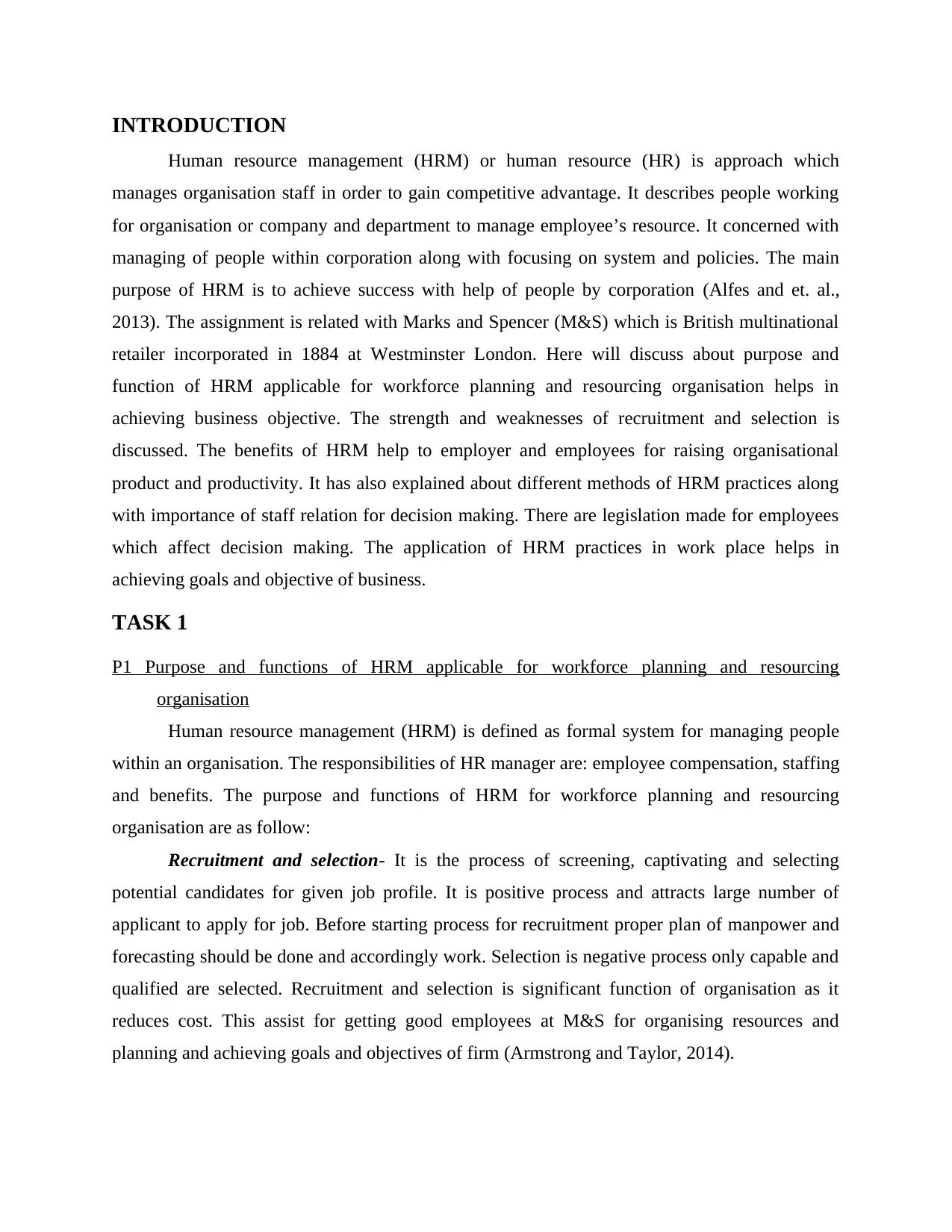
INTRODUCTION
Human resource management (HRM) or human resource (HR) is approach which
manages organisation staff in order to gain competitive advantage. It describes people working
for organisation or company and department to manage employee’s resource. It concerned with
managing of people within corporation along with focusing on system and policies. The main
purpose of HRM is to achieve success with help of people by corporation (Alfes and et. al.,
2013). The assignment is related with Marks and Spencer (M&S) which is British multinational
retailer incorporated in 1884 at Westminster London. Here will discuss about purpose and
function of HRM applicable for workforce planning and resourcing organisation helps in
achieving business objective. The strength and weaknesses of recruitment and selection is
discussed. The benefits of HRM help to employer and employees for raising organisational
product and productivity. It has also explained about different methods of HRM practices along
with importance of staff relation for decision making. There are legislation made for employees
which affect decision making. The application of HRM practices in work place helps in
achieving goals and objective of business.
TASK 1
P1 Purpose and functions of HRM applicable for workforce planning and resourcing
organisation
Human resource management (HRM) is defined as formal system for managing people
within an organisation. The responsibilities of HR manager are: employee compensation, staffing
and benefits. The purpose and functions of HRM for workforce planning and resourcing
organisation are as follow:
Recruitment and selection- It is the process of screening, captivating and selecting
potential candidates for given job profile. It is positive process and attracts large number of
applicant to apply for job. Before starting process for recruitment proper plan of manpower and
forecasting should be done and accordingly work. Selection is negative process only capable and
qualified are selected. Recruitment and selection is significant function of organisation as it
reduces cost. This assist for getting good employees at M&S for organising resources and
planning and achieving goals and objectives of firm (Armstrong and Taylor, 2014).
Human resource management (HRM) or human resource (HR) is approach which
manages organisation staff in order to gain competitive advantage. It describes people working
for organisation or company and department to manage employee’s resource. It concerned with
managing of people within corporation along with focusing on system and policies. The main
purpose of HRM is to achieve success with help of people by corporation (Alfes and et. al.,
2013). The assignment is related with Marks and Spencer (M&S) which is British multinational
retailer incorporated in 1884 at Westminster London. Here will discuss about purpose and
function of HRM applicable for workforce planning and resourcing organisation helps in
achieving business objective. The strength and weaknesses of recruitment and selection is
discussed. The benefits of HRM help to employer and employees for raising organisational
product and productivity. It has also explained about different methods of HRM practices along
with importance of staff relation for decision making. There are legislation made for employees
which affect decision making. The application of HRM practices in work place helps in
achieving goals and objective of business.
TASK 1
P1 Purpose and functions of HRM applicable for workforce planning and resourcing
organisation
Human resource management (HRM) is defined as formal system for managing people
within an organisation. The responsibilities of HR manager are: employee compensation, staffing
and benefits. The purpose and functions of HRM for workforce planning and resourcing
organisation are as follow:
Recruitment and selection- It is the process of screening, captivating and selecting
potential candidates for given job profile. It is positive process and attracts large number of
applicant to apply for job. Before starting process for recruitment proper plan of manpower and
forecasting should be done and accordingly work. Selection is negative process only capable and
qualified are selected. Recruitment and selection is significant function of organisation as it
reduces cost. This assist for getting good employees at M&S for organising resources and
planning and achieving goals and objectives of firm (Armstrong and Taylor, 2014).
⊘ This is a preview!⊘
Do you want full access?
Subscribe today to unlock all pages.

Trusted by 1+ million students worldwide
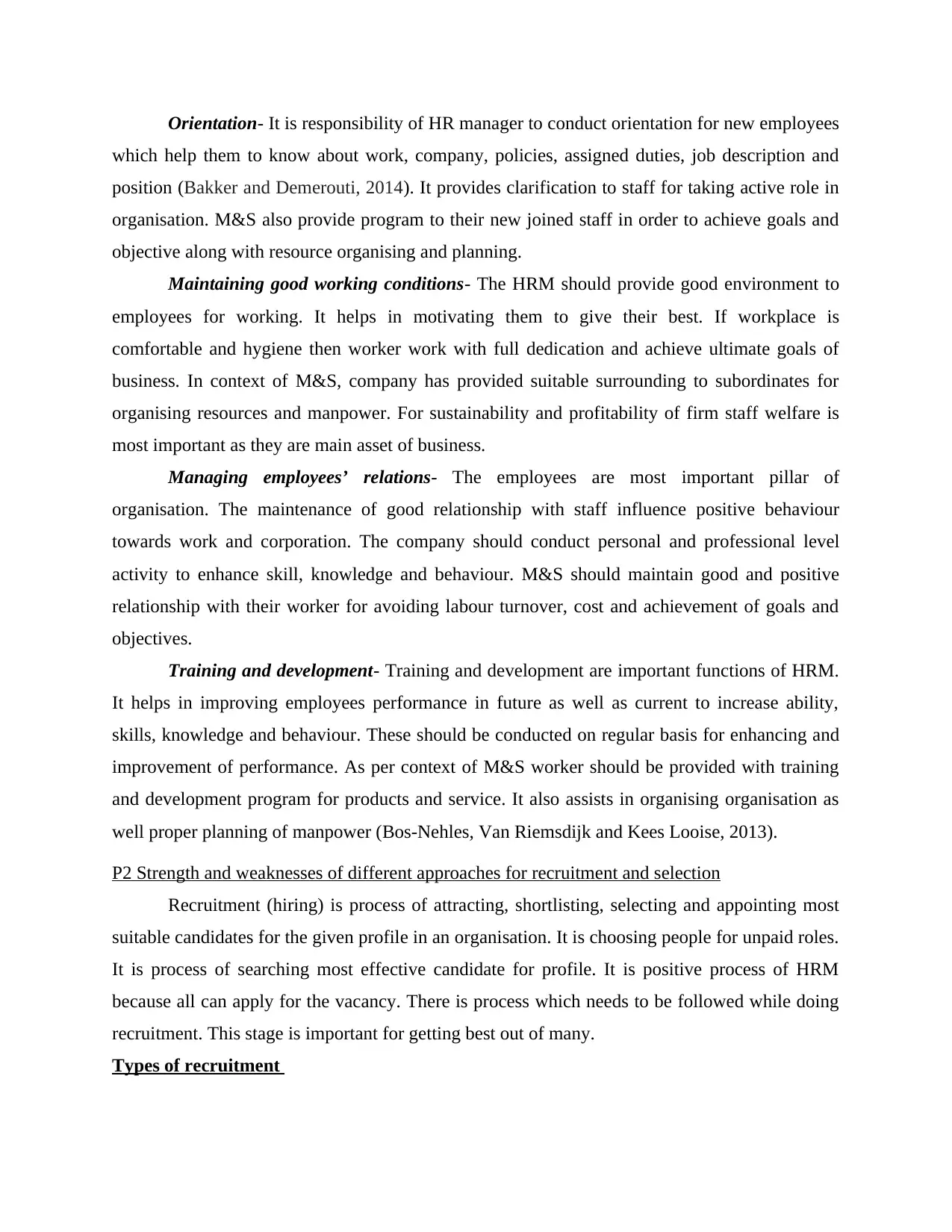
Orientation- It is responsibility of HR manager to conduct orientation for new employees
which help them to know about work, company, policies, assigned duties, job description and
position (Bakker and Demerouti, 2014). It provides clarification to staff for taking active role in
organisation. M&S also provide program to their new joined staff in order to achieve goals and
objective along with resource organising and planning.
Maintaining good working conditions- The HRM should provide good environment to
employees for working. It helps in motivating them to give their best. If workplace is
comfortable and hygiene then worker work with full dedication and achieve ultimate goals of
business. In context of M&S, company has provided suitable surrounding to subordinates for
organising resources and manpower. For sustainability and profitability of firm staff welfare is
most important as they are main asset of business.
Managing employees’ relations- The employees are most important pillar of
organisation. The maintenance of good relationship with staff influence positive behaviour
towards work and corporation. The company should conduct personal and professional level
activity to enhance skill, knowledge and behaviour. M&S should maintain good and positive
relationship with their worker for avoiding labour turnover, cost and achievement of goals and
objectives.
Training and development- Training and development are important functions of HRM.
It helps in improving employees performance in future as well as current to increase ability,
skills, knowledge and behaviour. These should be conducted on regular basis for enhancing and
improvement of performance. As per context of M&S worker should be provided with training
and development program for products and service. It also assists in organising organisation as
well proper planning of manpower (Bos‐Nehles, Van Riemsdijk and Kees Looise, 2013).
P2 Strength and weaknesses of different approaches for recruitment and selection
Recruitment (hiring) is process of attracting, shortlisting, selecting and appointing most
suitable candidates for the given profile in an organisation. It is choosing people for unpaid roles.
It is process of searching most effective candidate for profile. It is positive process of HRM
because all can apply for the vacancy. There is process which needs to be followed while doing
recruitment. This stage is important for getting best out of many.
Types of recruitment
which help them to know about work, company, policies, assigned duties, job description and
position (Bakker and Demerouti, 2014). It provides clarification to staff for taking active role in
organisation. M&S also provide program to their new joined staff in order to achieve goals and
objective along with resource organising and planning.
Maintaining good working conditions- The HRM should provide good environment to
employees for working. It helps in motivating them to give their best. If workplace is
comfortable and hygiene then worker work with full dedication and achieve ultimate goals of
business. In context of M&S, company has provided suitable surrounding to subordinates for
organising resources and manpower. For sustainability and profitability of firm staff welfare is
most important as they are main asset of business.
Managing employees’ relations- The employees are most important pillar of
organisation. The maintenance of good relationship with staff influence positive behaviour
towards work and corporation. The company should conduct personal and professional level
activity to enhance skill, knowledge and behaviour. M&S should maintain good and positive
relationship with their worker for avoiding labour turnover, cost and achievement of goals and
objectives.
Training and development- Training and development are important functions of HRM.
It helps in improving employees performance in future as well as current to increase ability,
skills, knowledge and behaviour. These should be conducted on regular basis for enhancing and
improvement of performance. As per context of M&S worker should be provided with training
and development program for products and service. It also assists in organising organisation as
well proper planning of manpower (Bos‐Nehles, Van Riemsdijk and Kees Looise, 2013).
P2 Strength and weaknesses of different approaches for recruitment and selection
Recruitment (hiring) is process of attracting, shortlisting, selecting and appointing most
suitable candidates for the given profile in an organisation. It is choosing people for unpaid roles.
It is process of searching most effective candidate for profile. It is positive process of HRM
because all can apply for the vacancy. There is process which needs to be followed while doing
recruitment. This stage is important for getting best out of many.
Types of recruitment
Paraphrase This Document
Need a fresh take? Get an instant paraphrase of this document with our AI Paraphraser
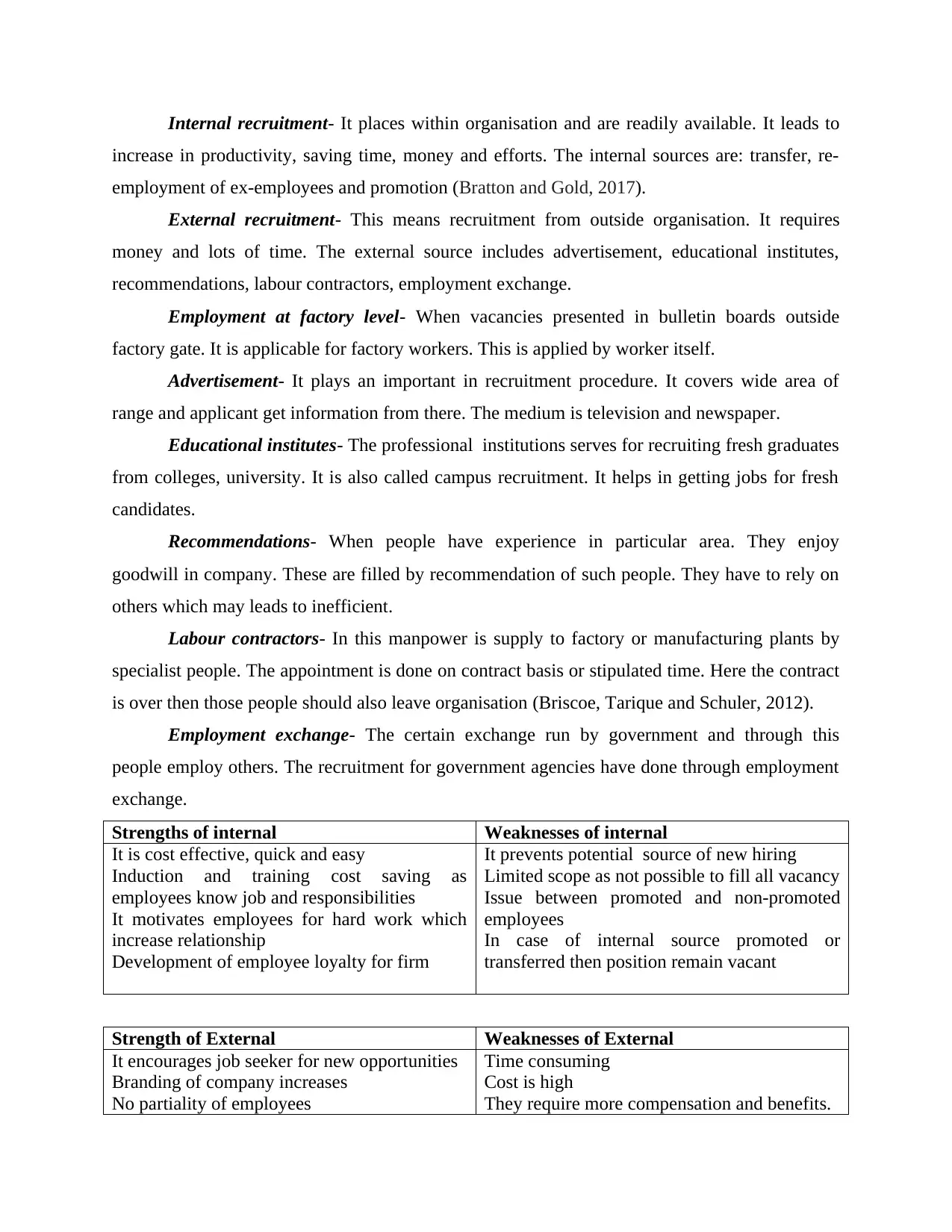
Internal recruitment- It places within organisation and are readily available. It leads to
increase in productivity, saving time, money and efforts. The internal sources are: transfer, re-
employment of ex-employees and promotion (Bratton and Gold, 2017).
External recruitment- This means recruitment from outside organisation. It requires
money and lots of time. The external source includes advertisement, educational institutes,
recommendations, labour contractors, employment exchange.
Employment at factory level- When vacancies presented in bulletin boards outside
factory gate. It is applicable for factory workers. This is applied by worker itself.
Advertisement- It plays an important in recruitment procedure. It covers wide area of
range and applicant get information from there. The medium is television and newspaper.
Educational institutes- The professional institutions serves for recruiting fresh graduates
from colleges, university. It is also called campus recruitment. It helps in getting jobs for fresh
candidates.
Recommendations- When people have experience in particular area. They enjoy
goodwill in company. These are filled by recommendation of such people. They have to rely on
others which may leads to inefficient.
Labour contractors- In this manpower is supply to factory or manufacturing plants by
specialist people. The appointment is done on contract basis or stipulated time. Here the contract
is over then those people should also leave organisation (Briscoe, Tarique and Schuler, 2012).
Employment exchange- The certain exchange run by government and through this
people employ others. The recruitment for government agencies have done through employment
exchange.
Strengths of internal Weaknesses of internal
It is cost effective, quick and easy
Induction and training cost saving as
employees know job and responsibilities
It motivates employees for hard work which
increase relationship
Development of employee loyalty for firm
It prevents potential source of new hiring
Limited scope as not possible to fill all vacancy
Issue between promoted and non-promoted
employees
In case of internal source promoted or
transferred then position remain vacant
Strength of External Weaknesses of External
It encourages job seeker for new opportunities
Branding of company increases
No partiality of employees
Time consuming
Cost is high
They require more compensation and benefits.
increase in productivity, saving time, money and efforts. The internal sources are: transfer, re-
employment of ex-employees and promotion (Bratton and Gold, 2017).
External recruitment- This means recruitment from outside organisation. It requires
money and lots of time. The external source includes advertisement, educational institutes,
recommendations, labour contractors, employment exchange.
Employment at factory level- When vacancies presented in bulletin boards outside
factory gate. It is applicable for factory workers. This is applied by worker itself.
Advertisement- It plays an important in recruitment procedure. It covers wide area of
range and applicant get information from there. The medium is television and newspaper.
Educational institutes- The professional institutions serves for recruiting fresh graduates
from colleges, university. It is also called campus recruitment. It helps in getting jobs for fresh
candidates.
Recommendations- When people have experience in particular area. They enjoy
goodwill in company. These are filled by recommendation of such people. They have to rely on
others which may leads to inefficient.
Labour contractors- In this manpower is supply to factory or manufacturing plants by
specialist people. The appointment is done on contract basis or stipulated time. Here the contract
is over then those people should also leave organisation (Briscoe, Tarique and Schuler, 2012).
Employment exchange- The certain exchange run by government and through this
people employ others. The recruitment for government agencies have done through employment
exchange.
Strengths of internal Weaknesses of internal
It is cost effective, quick and easy
Induction and training cost saving as
employees know job and responsibilities
It motivates employees for hard work which
increase relationship
Development of employee loyalty for firm
It prevents potential source of new hiring
Limited scope as not possible to fill all vacancy
Issue between promoted and non-promoted
employees
In case of internal source promoted or
transferred then position remain vacant
Strength of External Weaknesses of External
It encourages job seeker for new opportunities
Branding of company increases
No partiality of employees
Time consuming
Cost is high
They require more compensation and benefits.
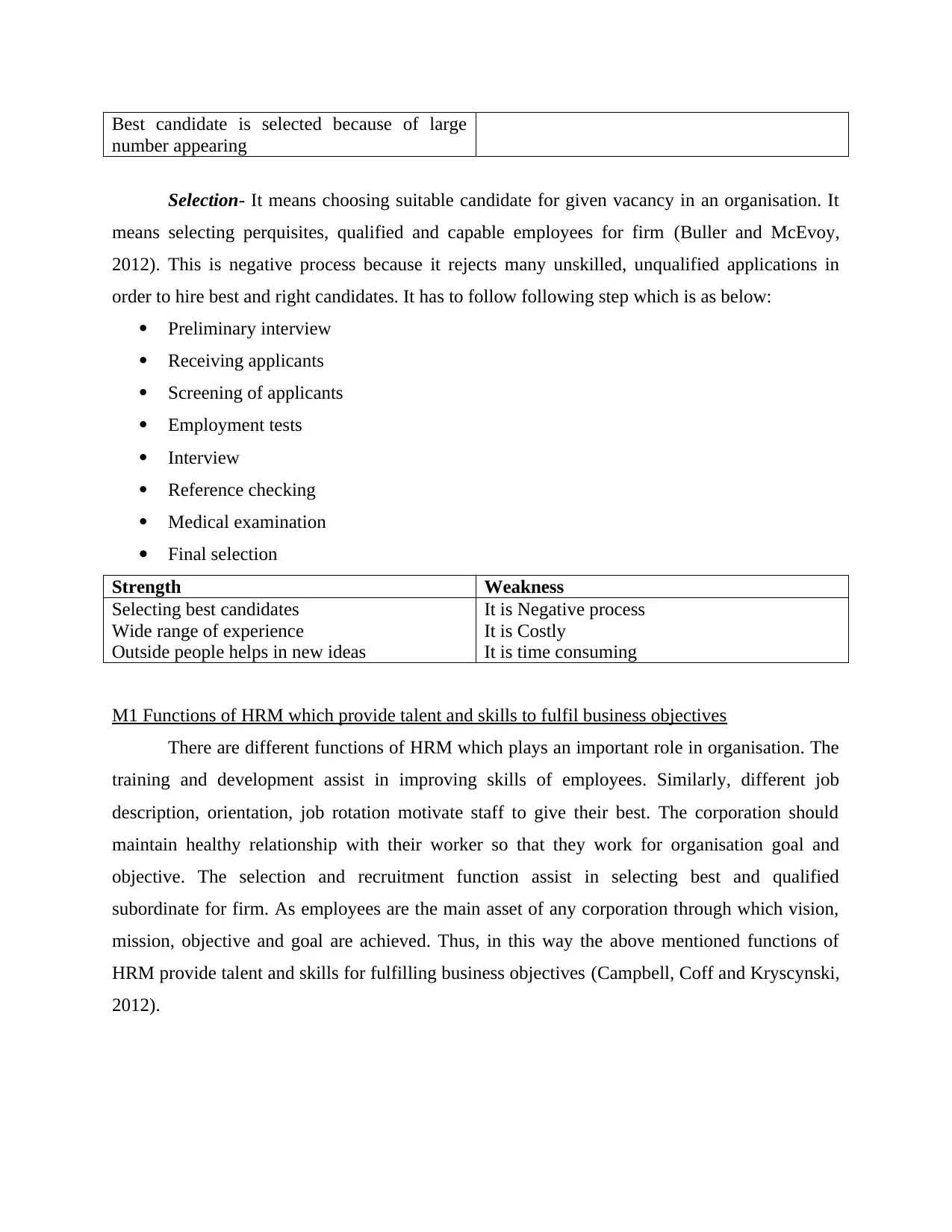
Best candidate is selected because of large
number appearing
Selection- It means choosing suitable candidate for given vacancy in an organisation. It
means selecting perquisites, qualified and capable employees for firm (Buller and McEvoy,
2012). This is negative process because it rejects many unskilled, unqualified applications in
order to hire best and right candidates. It has to follow following step which is as below:
Preliminary interview
Receiving applicants
Screening of applicants
Employment tests
Interview
Reference checking
Medical examination
Final selection
Strength Weakness
Selecting best candidates
Wide range of experience
Outside people helps in new ideas
It is Negative process
It is Costly
It is time consuming
M1 Functions of HRM which provide talent and skills to fulfil business objectives
There are different functions of HRM which plays an important role in organisation. The
training and development assist in improving skills of employees. Similarly, different job
description, orientation, job rotation motivate staff to give their best. The corporation should
maintain healthy relationship with their worker so that they work for organisation goal and
objective. The selection and recruitment function assist in selecting best and qualified
subordinate for firm. As employees are the main asset of any corporation through which vision,
mission, objective and goal are achieved. Thus, in this way the above mentioned functions of
HRM provide talent and skills for fulfilling business objectives (Campbell, Coff and Kryscynski,
2012).
number appearing
Selection- It means choosing suitable candidate for given vacancy in an organisation. It
means selecting perquisites, qualified and capable employees for firm (Buller and McEvoy,
2012). This is negative process because it rejects many unskilled, unqualified applications in
order to hire best and right candidates. It has to follow following step which is as below:
Preliminary interview
Receiving applicants
Screening of applicants
Employment tests
Interview
Reference checking
Medical examination
Final selection
Strength Weakness
Selecting best candidates
Wide range of experience
Outside people helps in new ideas
It is Negative process
It is Costly
It is time consuming
M1 Functions of HRM which provide talent and skills to fulfil business objectives
There are different functions of HRM which plays an important role in organisation. The
training and development assist in improving skills of employees. Similarly, different job
description, orientation, job rotation motivate staff to give their best. The corporation should
maintain healthy relationship with their worker so that they work for organisation goal and
objective. The selection and recruitment function assist in selecting best and qualified
subordinate for firm. As employees are the main asset of any corporation through which vision,
mission, objective and goal are achieved. Thus, in this way the above mentioned functions of
HRM provide talent and skills for fulfilling business objectives (Campbell, Coff and Kryscynski,
2012).
⊘ This is a preview!⊘
Do you want full access?
Subscribe today to unlock all pages.

Trusted by 1+ million students worldwide
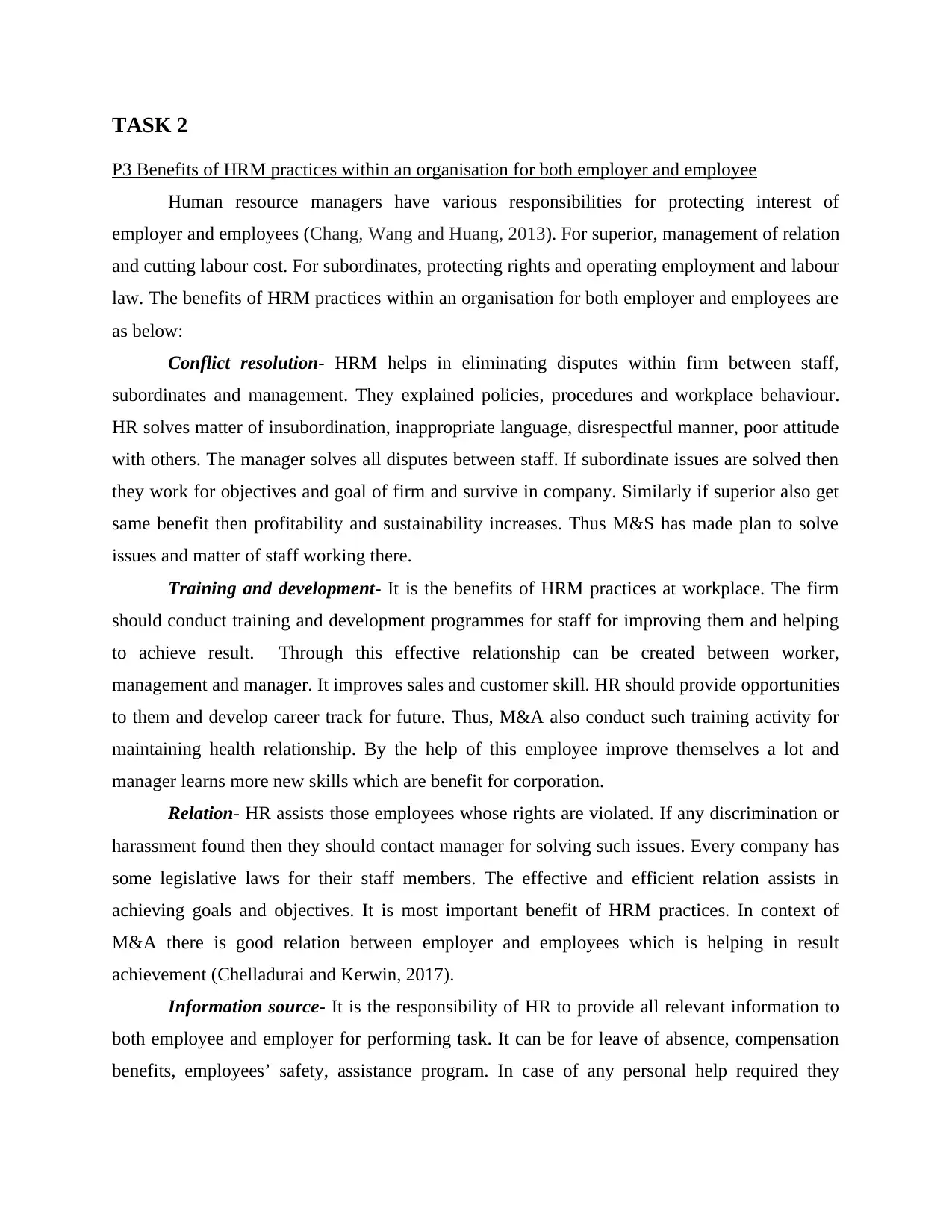
TASK 2
P3 Benefits of HRM practices within an organisation for both employer and employee
Human resource managers have various responsibilities for protecting interest of
employer and employees (Chang, Wang and Huang, 2013). For superior, management of relation
and cutting labour cost. For subordinates, protecting rights and operating employment and labour
law. The benefits of HRM practices within an organisation for both employer and employees are
as below:
Conflict resolution- HRM helps in eliminating disputes within firm between staff,
subordinates and management. They explained policies, procedures and workplace behaviour.
HR solves matter of insubordination, inappropriate language, disrespectful manner, poor attitude
with others. The manager solves all disputes between staff. If subordinate issues are solved then
they work for objectives and goal of firm and survive in company. Similarly if superior also get
same benefit then profitability and sustainability increases. Thus M&S has made plan to solve
issues and matter of staff working there.
Training and development- It is the benefits of HRM practices at workplace. The firm
should conduct training and development programmes for staff for improving them and helping
to achieve result. Through this effective relationship can be created between worker,
management and manager. It improves sales and customer skill. HR should provide opportunities
to them and develop career track for future. Thus, M&A also conduct such training activity for
maintaining health relationship. By the help of this employee improve themselves a lot and
manager learns more new skills which are benefit for corporation.
Relation- HR assists those employees whose rights are violated. If any discrimination or
harassment found then they should contact manager for solving such issues. Every company has
some legislative laws for their staff members. The effective and efficient relation assists in
achieving goals and objectives. It is most important benefit of HRM practices. In context of
M&A there is good relation between employer and employees which is helping in result
achievement (Chelladurai and Kerwin, 2017).
Information source- It is the responsibility of HR to provide all relevant information to
both employee and employer for performing task. It can be for leave of absence, compensation
benefits, employees’ safety, assistance program. In case of any personal help required they
P3 Benefits of HRM practices within an organisation for both employer and employee
Human resource managers have various responsibilities for protecting interest of
employer and employees (Chang, Wang and Huang, 2013). For superior, management of relation
and cutting labour cost. For subordinates, protecting rights and operating employment and labour
law. The benefits of HRM practices within an organisation for both employer and employees are
as below:
Conflict resolution- HRM helps in eliminating disputes within firm between staff,
subordinates and management. They explained policies, procedures and workplace behaviour.
HR solves matter of insubordination, inappropriate language, disrespectful manner, poor attitude
with others. The manager solves all disputes between staff. If subordinate issues are solved then
they work for objectives and goal of firm and survive in company. Similarly if superior also get
same benefit then profitability and sustainability increases. Thus M&S has made plan to solve
issues and matter of staff working there.
Training and development- It is the benefits of HRM practices at workplace. The firm
should conduct training and development programmes for staff for improving them and helping
to achieve result. Through this effective relationship can be created between worker,
management and manager. It improves sales and customer skill. HR should provide opportunities
to them and develop career track for future. Thus, M&A also conduct such training activity for
maintaining health relationship. By the help of this employee improve themselves a lot and
manager learns more new skills which are benefit for corporation.
Relation- HR assists those employees whose rights are violated. If any discrimination or
harassment found then they should contact manager for solving such issues. Every company has
some legislative laws for their staff members. The effective and efficient relation assists in
achieving goals and objectives. It is most important benefit of HRM practices. In context of
M&A there is good relation between employer and employees which is helping in result
achievement (Chelladurai and Kerwin, 2017).
Information source- It is the responsibility of HR to provide all relevant information to
both employee and employer for performing task. It can be for leave of absence, compensation
benefits, employees’ safety, assistance program. In case of any personal help required they
Paraphrase This Document
Need a fresh take? Get an instant paraphrase of this document with our AI Paraphraser
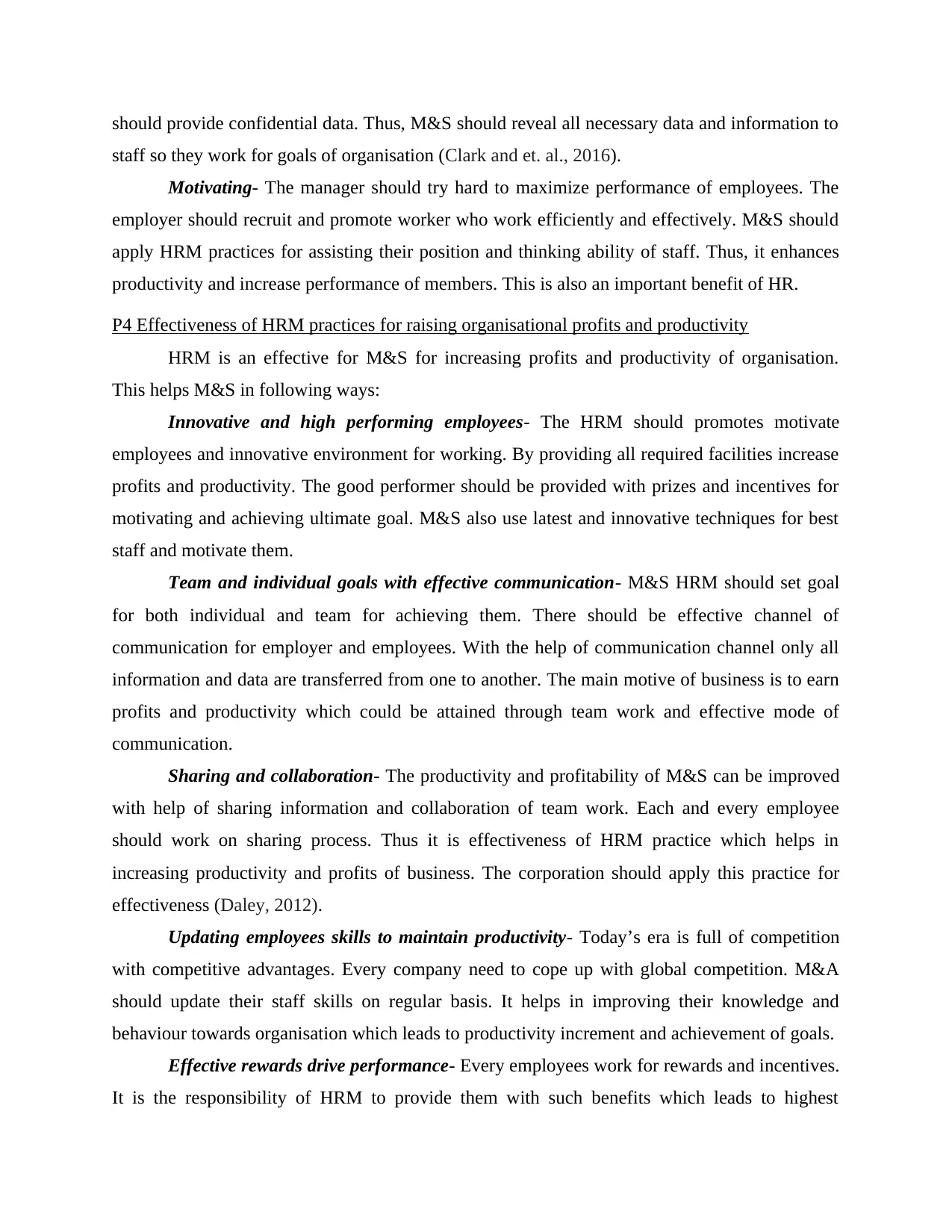
should provide confidential data. Thus, M&S should reveal all necessary data and information to
staff so they work for goals of organisation (Clark and et. al., 2016).
Motivating- The manager should try hard to maximize performance of employees. The
employer should recruit and promote worker who work efficiently and effectively. M&S should
apply HRM practices for assisting their position and thinking ability of staff. Thus, it enhances
productivity and increase performance of members. This is also an important benefit of HR.
P4 Effectiveness of HRM practices for raising organisational profits and productivity
HRM is an effective for M&S for increasing profits and productivity of organisation.
This helps M&S in following ways:
Innovative and high performing employees- The HRM should promotes motivate
employees and innovative environment for working. By providing all required facilities increase
profits and productivity. The good performer should be provided with prizes and incentives for
motivating and achieving ultimate goal. M&S also use latest and innovative techniques for best
staff and motivate them.
Team and individual goals with effective communication- M&S HRM should set goal
for both individual and team for achieving them. There should be effective channel of
communication for employer and employees. With the help of communication channel only all
information and data are transferred from one to another. The main motive of business is to earn
profits and productivity which could be attained through team work and effective mode of
communication.
Sharing and collaboration- The productivity and profitability of M&S can be improved
with help of sharing information and collaboration of team work. Each and every employee
should work on sharing process. Thus it is effectiveness of HRM practice which helps in
increasing productivity and profits of business. The corporation should apply this practice for
effectiveness (Daley, 2012).
Updating employees skills to maintain productivity- Today’s era is full of competition
with competitive advantages. Every company need to cope up with global competition. M&A
should update their staff skills on regular basis. It helps in improving their knowledge and
behaviour towards organisation which leads to productivity increment and achievement of goals.
Effective rewards drive performance- Every employees work for rewards and incentives.
It is the responsibility of HRM to provide them with such benefits which leads to highest
staff so they work for goals of organisation (Clark and et. al., 2016).
Motivating- The manager should try hard to maximize performance of employees. The
employer should recruit and promote worker who work efficiently and effectively. M&S should
apply HRM practices for assisting their position and thinking ability of staff. Thus, it enhances
productivity and increase performance of members. This is also an important benefit of HR.
P4 Effectiveness of HRM practices for raising organisational profits and productivity
HRM is an effective for M&S for increasing profits and productivity of organisation.
This helps M&S in following ways:
Innovative and high performing employees- The HRM should promotes motivate
employees and innovative environment for working. By providing all required facilities increase
profits and productivity. The good performer should be provided with prizes and incentives for
motivating and achieving ultimate goal. M&S also use latest and innovative techniques for best
staff and motivate them.
Team and individual goals with effective communication- M&S HRM should set goal
for both individual and team for achieving them. There should be effective channel of
communication for employer and employees. With the help of communication channel only all
information and data are transferred from one to another. The main motive of business is to earn
profits and productivity which could be attained through team work and effective mode of
communication.
Sharing and collaboration- The productivity and profitability of M&S can be improved
with help of sharing information and collaboration of team work. Each and every employee
should work on sharing process. Thus it is effectiveness of HRM practice which helps in
increasing productivity and profits of business. The corporation should apply this practice for
effectiveness (Daley, 2012).
Updating employees skills to maintain productivity- Today’s era is full of competition
with competitive advantages. Every company need to cope up with global competition. M&A
should update their staff skills on regular basis. It helps in improving their knowledge and
behaviour towards organisation which leads to productivity increment and achievement of goals.
Effective rewards drive performance- Every employees work for rewards and incentives.
It is the responsibility of HRM to provide them with such benefits which leads to highest
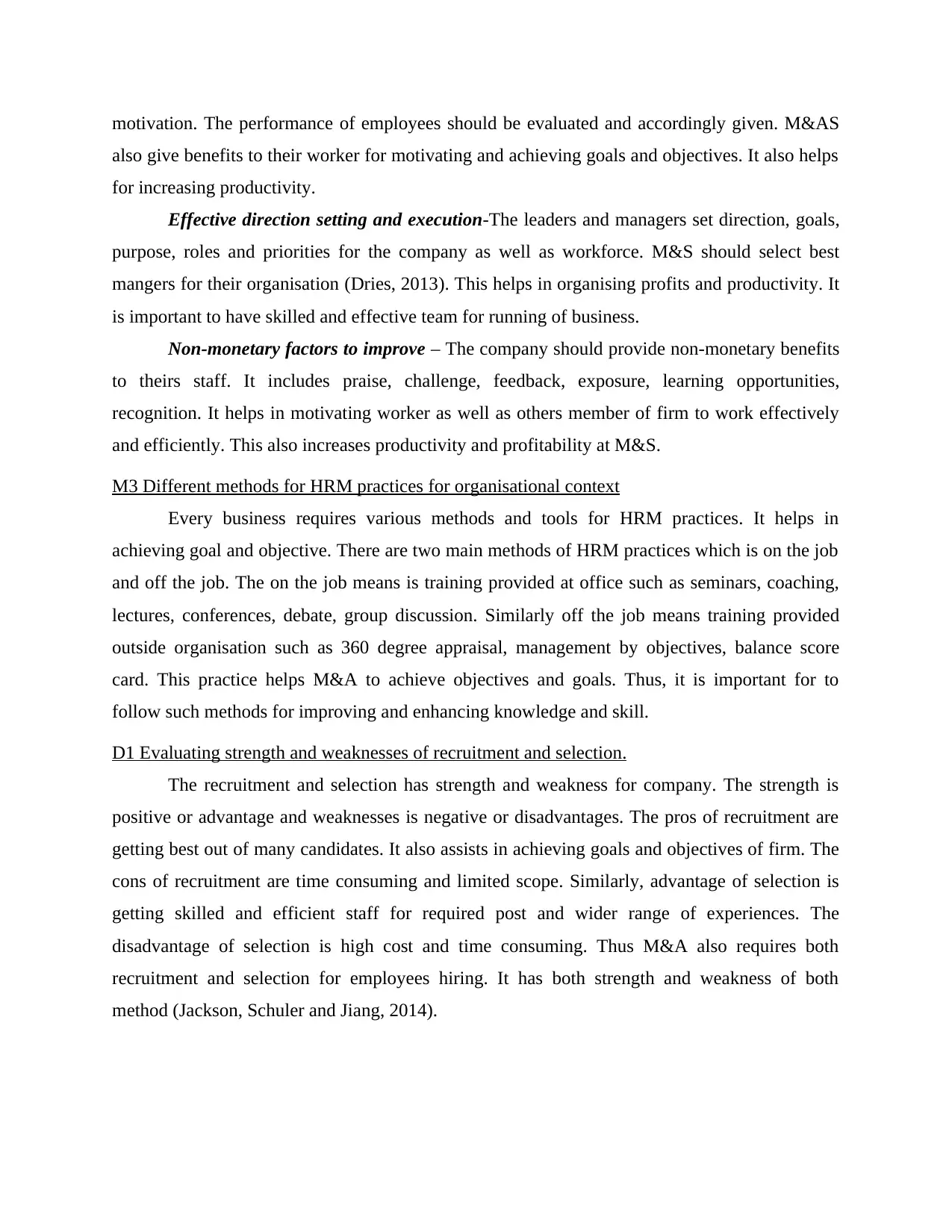
motivation. The performance of employees should be evaluated and accordingly given. M&AS
also give benefits to their worker for motivating and achieving goals and objectives. It also helps
for increasing productivity.
Effective direction setting and execution-The leaders and managers set direction, goals,
purpose, roles and priorities for the company as well as workforce. M&S should select best
mangers for their organisation (Dries, 2013). This helps in organising profits and productivity. It
is important to have skilled and effective team for running of business.
Non-monetary factors to improve – The company should provide non-monetary benefits
to theirs staff. It includes praise, challenge, feedback, exposure, learning opportunities,
recognition. It helps in motivating worker as well as others member of firm to work effectively
and efficiently. This also increases productivity and profitability at M&S.
M3 Different methods for HRM practices for organisational context
Every business requires various methods and tools for HRM practices. It helps in
achieving goal and objective. There are two main methods of HRM practices which is on the job
and off the job. The on the job means is training provided at office such as seminars, coaching,
lectures, conferences, debate, group discussion. Similarly off the job means training provided
outside organisation such as 360 degree appraisal, management by objectives, balance score
card. This practice helps M&A to achieve objectives and goals. Thus, it is important for to
follow such methods for improving and enhancing knowledge and skill.
D1 Evaluating strength and weaknesses of recruitment and selection.
The recruitment and selection has strength and weakness for company. The strength is
positive or advantage and weaknesses is negative or disadvantages. The pros of recruitment are
getting best out of many candidates. It also assists in achieving goals and objectives of firm. The
cons of recruitment are time consuming and limited scope. Similarly, advantage of selection is
getting skilled and efficient staff for required post and wider range of experiences. The
disadvantage of selection is high cost and time consuming. Thus M&A also requires both
recruitment and selection for employees hiring. It has both strength and weakness of both
method (Jackson, Schuler and Jiang, 2014).
also give benefits to their worker for motivating and achieving goals and objectives. It also helps
for increasing productivity.
Effective direction setting and execution-The leaders and managers set direction, goals,
purpose, roles and priorities for the company as well as workforce. M&S should select best
mangers for their organisation (Dries, 2013). This helps in organising profits and productivity. It
is important to have skilled and effective team for running of business.
Non-monetary factors to improve – The company should provide non-monetary benefits
to theirs staff. It includes praise, challenge, feedback, exposure, learning opportunities,
recognition. It helps in motivating worker as well as others member of firm to work effectively
and efficiently. This also increases productivity and profitability at M&S.
M3 Different methods for HRM practices for organisational context
Every business requires various methods and tools for HRM practices. It helps in
achieving goal and objective. There are two main methods of HRM practices which is on the job
and off the job. The on the job means is training provided at office such as seminars, coaching,
lectures, conferences, debate, group discussion. Similarly off the job means training provided
outside organisation such as 360 degree appraisal, management by objectives, balance score
card. This practice helps M&A to achieve objectives and goals. Thus, it is important for to
follow such methods for improving and enhancing knowledge and skill.
D1 Evaluating strength and weaknesses of recruitment and selection.
The recruitment and selection has strength and weakness for company. The strength is
positive or advantage and weaknesses is negative or disadvantages. The pros of recruitment are
getting best out of many candidates. It also assists in achieving goals and objectives of firm. The
cons of recruitment are time consuming and limited scope. Similarly, advantage of selection is
getting skilled and efficient staff for required post and wider range of experiences. The
disadvantage of selection is high cost and time consuming. Thus M&A also requires both
recruitment and selection for employees hiring. It has both strength and weakness of both
method (Jackson, Schuler and Jiang, 2014).
⊘ This is a preview!⊘
Do you want full access?
Subscribe today to unlock all pages.

Trusted by 1+ million students worldwide
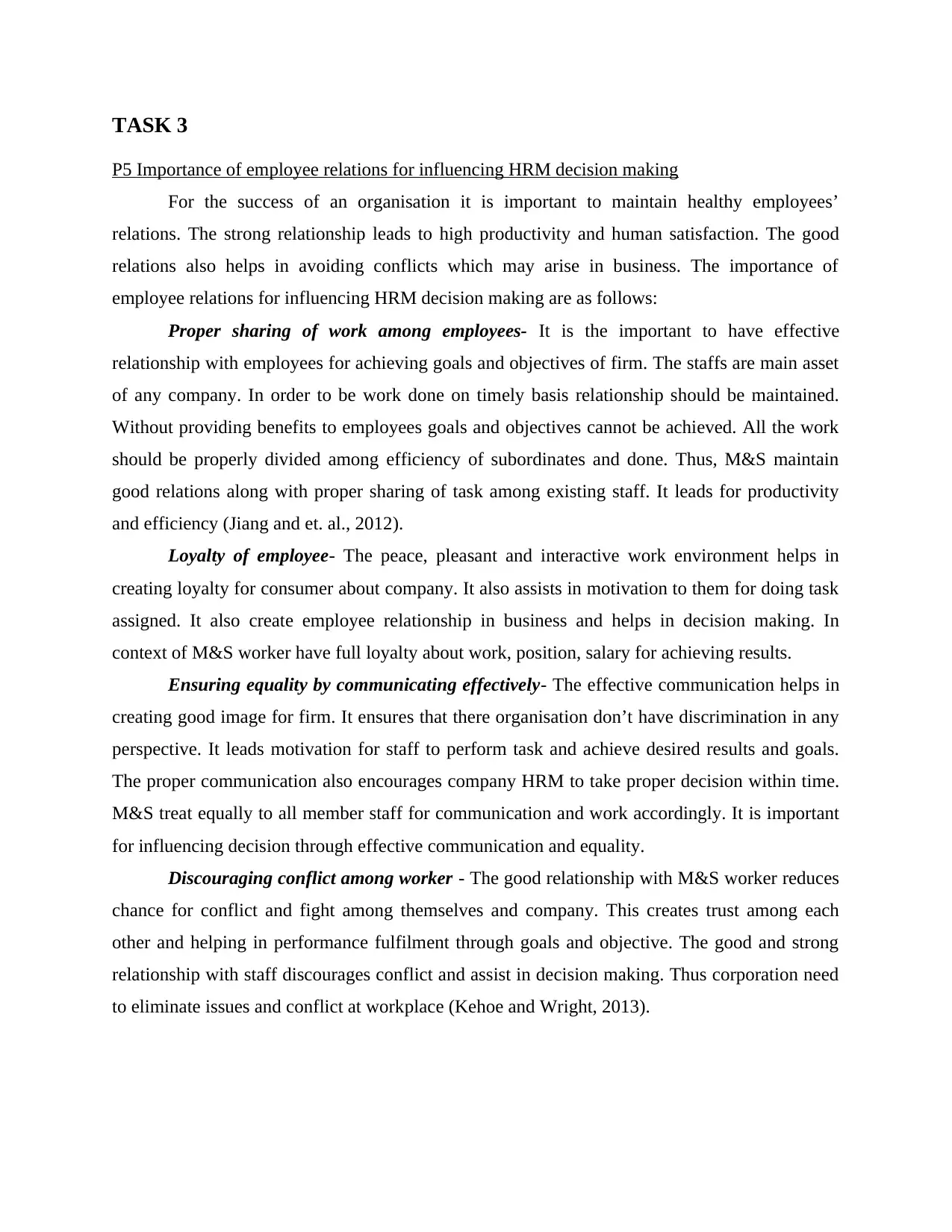
TASK 3
P5 Importance of employee relations for influencing HRM decision making
For the success of an organisation it is important to maintain healthy employees’
relations. The strong relationship leads to high productivity and human satisfaction. The good
relations also helps in avoiding conflicts which may arise in business. The importance of
employee relations for influencing HRM decision making are as follows:
Proper sharing of work among employees- It is the important to have effective
relationship with employees for achieving goals and objectives of firm. The staffs are main asset
of any company. In order to be work done on timely basis relationship should be maintained.
Without providing benefits to employees goals and objectives cannot be achieved. All the work
should be properly divided among efficiency of subordinates and done. Thus, M&S maintain
good relations along with proper sharing of task among existing staff. It leads for productivity
and efficiency (Jiang and et. al., 2012).
Loyalty of employee- The peace, pleasant and interactive work environment helps in
creating loyalty for consumer about company. It also assists in motivation to them for doing task
assigned. It also create employee relationship in business and helps in decision making. In
context of M&S worker have full loyalty about work, position, salary for achieving results.
Ensuring equality by communicating effectively- The effective communication helps in
creating good image for firm. It ensures that there organisation don’t have discrimination in any
perspective. It leads motivation for staff to perform task and achieve desired results and goals.
The proper communication also encourages company HRM to take proper decision within time.
M&S treat equally to all member staff for communication and work accordingly. It is important
for influencing decision through effective communication and equality.
Discouraging conflict among worker - The good relationship with M&S worker reduces
chance for conflict and fight among themselves and company. This creates trust among each
other and helping in performance fulfilment through goals and objective. The good and strong
relationship with staff discourages conflict and assist in decision making. Thus corporation need
to eliminate issues and conflict at workplace (Kehoe and Wright, 2013).
P5 Importance of employee relations for influencing HRM decision making
For the success of an organisation it is important to maintain healthy employees’
relations. The strong relationship leads to high productivity and human satisfaction. The good
relations also helps in avoiding conflicts which may arise in business. The importance of
employee relations for influencing HRM decision making are as follows:
Proper sharing of work among employees- It is the important to have effective
relationship with employees for achieving goals and objectives of firm. The staffs are main asset
of any company. In order to be work done on timely basis relationship should be maintained.
Without providing benefits to employees goals and objectives cannot be achieved. All the work
should be properly divided among efficiency of subordinates and done. Thus, M&S maintain
good relations along with proper sharing of task among existing staff. It leads for productivity
and efficiency (Jiang and et. al., 2012).
Loyalty of employee- The peace, pleasant and interactive work environment helps in
creating loyalty for consumer about company. It also assists in motivation to them for doing task
assigned. It also create employee relationship in business and helps in decision making. In
context of M&S worker have full loyalty about work, position, salary for achieving results.
Ensuring equality by communicating effectively- The effective communication helps in
creating good image for firm. It ensures that there organisation don’t have discrimination in any
perspective. It leads motivation for staff to perform task and achieve desired results and goals.
The proper communication also encourages company HRM to take proper decision within time.
M&S treat equally to all member staff for communication and work accordingly. It is important
for influencing decision through effective communication and equality.
Discouraging conflict among worker - The good relationship with M&S worker reduces
chance for conflict and fight among themselves and company. This creates trust among each
other and helping in performance fulfilment through goals and objective. The good and strong
relationship with staff discourages conflict and assist in decision making. Thus corporation need
to eliminate issues and conflict at workplace (Kehoe and Wright, 2013).
Paraphrase This Document
Need a fresh take? Get an instant paraphrase of this document with our AI Paraphraser
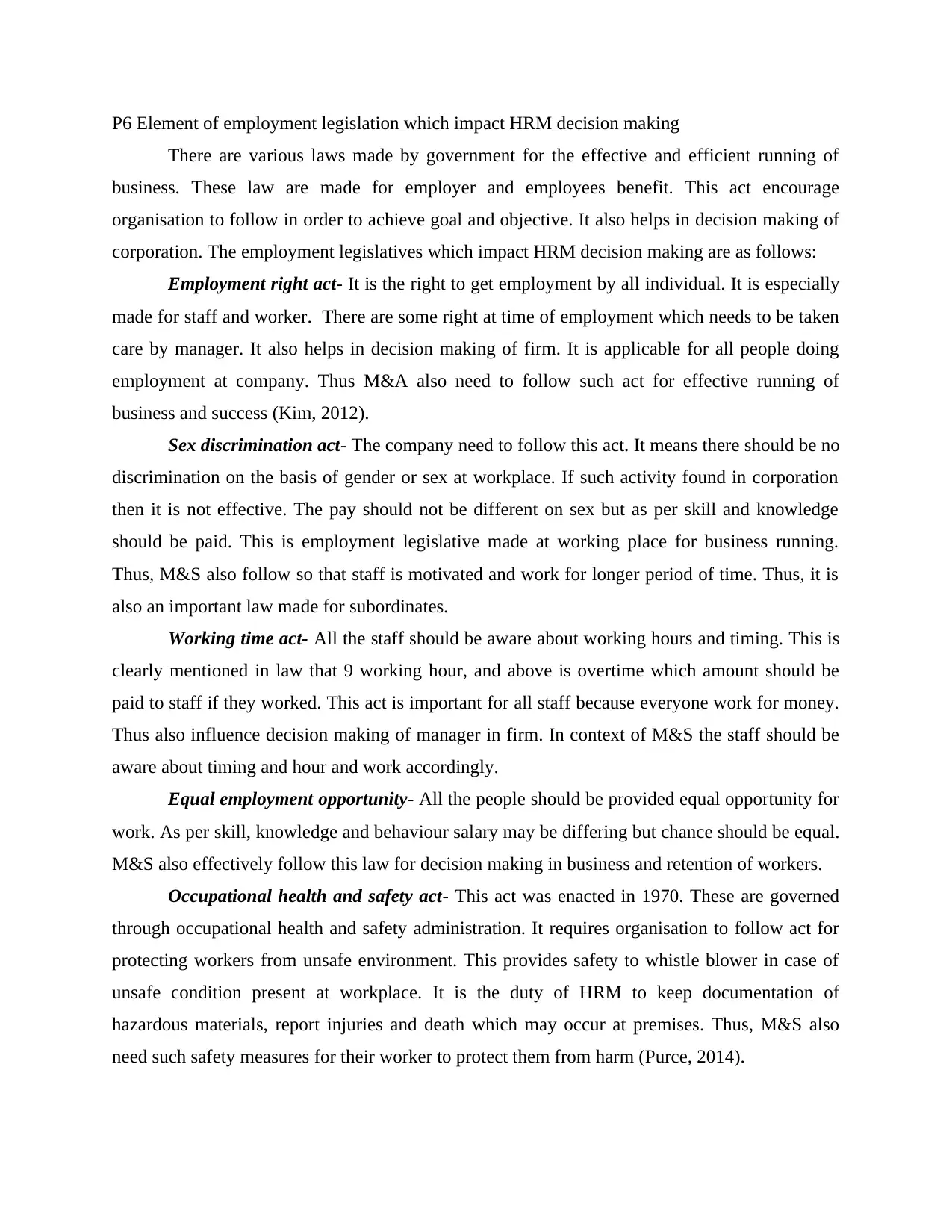
P6 Element of employment legislation which impact HRM decision making
There are various laws made by government for the effective and efficient running of
business. These law are made for employer and employees benefit. This act encourage
organisation to follow in order to achieve goal and objective. It also helps in decision making of
corporation. The employment legislatives which impact HRM decision making are as follows:
Employment right act- It is the right to get employment by all individual. It is especially
made for staff and worker. There are some right at time of employment which needs to be taken
care by manager. It also helps in decision making of firm. It is applicable for all people doing
employment at company. Thus M&A also need to follow such act for effective running of
business and success (Kim, 2012).
Sex discrimination act- The company need to follow this act. It means there should be no
discrimination on the basis of gender or sex at workplace. If such activity found in corporation
then it is not effective. The pay should not be different on sex but as per skill and knowledge
should be paid. This is employment legislative made at working place for business running.
Thus, M&S also follow so that staff is motivated and work for longer period of time. Thus, it is
also an important law made for subordinates.
Working time act- All the staff should be aware about working hours and timing. This is
clearly mentioned in law that 9 working hour, and above is overtime which amount should be
paid to staff if they worked. This act is important for all staff because everyone work for money.
Thus also influence decision making of manager in firm. In context of M&S the staff should be
aware about timing and hour and work accordingly.
Equal employment opportunity- All the people should be provided equal opportunity for
work. As per skill, knowledge and behaviour salary may be differing but chance should be equal.
M&S also effectively follow this law for decision making in business and retention of workers.
Occupational health and safety act- This act was enacted in 1970. These are governed
through occupational health and safety administration. It requires organisation to follow act for
protecting workers from unsafe environment. This provides safety to whistle blower in case of
unsafe condition present at workplace. It is the duty of HRM to keep documentation of
hazardous materials, report injuries and death which may occur at premises. Thus, M&S also
need such safety measures for their worker to protect them from harm (Purce, 2014).
There are various laws made by government for the effective and efficient running of
business. These law are made for employer and employees benefit. This act encourage
organisation to follow in order to achieve goal and objective. It also helps in decision making of
corporation. The employment legislatives which impact HRM decision making are as follows:
Employment right act- It is the right to get employment by all individual. It is especially
made for staff and worker. There are some right at time of employment which needs to be taken
care by manager. It also helps in decision making of firm. It is applicable for all people doing
employment at company. Thus M&A also need to follow such act for effective running of
business and success (Kim, 2012).
Sex discrimination act- The company need to follow this act. It means there should be no
discrimination on the basis of gender or sex at workplace. If such activity found in corporation
then it is not effective. The pay should not be different on sex but as per skill and knowledge
should be paid. This is employment legislative made at working place for business running.
Thus, M&S also follow so that staff is motivated and work for longer period of time. Thus, it is
also an important law made for subordinates.
Working time act- All the staff should be aware about working hours and timing. This is
clearly mentioned in law that 9 working hour, and above is overtime which amount should be
paid to staff if they worked. This act is important for all staff because everyone work for money.
Thus also influence decision making of manager in firm. In context of M&S the staff should be
aware about timing and hour and work accordingly.
Equal employment opportunity- All the people should be provided equal opportunity for
work. As per skill, knowledge and behaviour salary may be differing but chance should be equal.
M&S also effectively follow this law for decision making in business and retention of workers.
Occupational health and safety act- This act was enacted in 1970. These are governed
through occupational health and safety administration. It requires organisation to follow act for
protecting workers from unsafe environment. This provides safety to whistle blower in case of
unsafe condition present at workplace. It is the duty of HRM to keep documentation of
hazardous materials, report injuries and death which may occur at premises. Thus, M&S also
need such safety measures for their worker to protect them from harm (Purce, 2014).
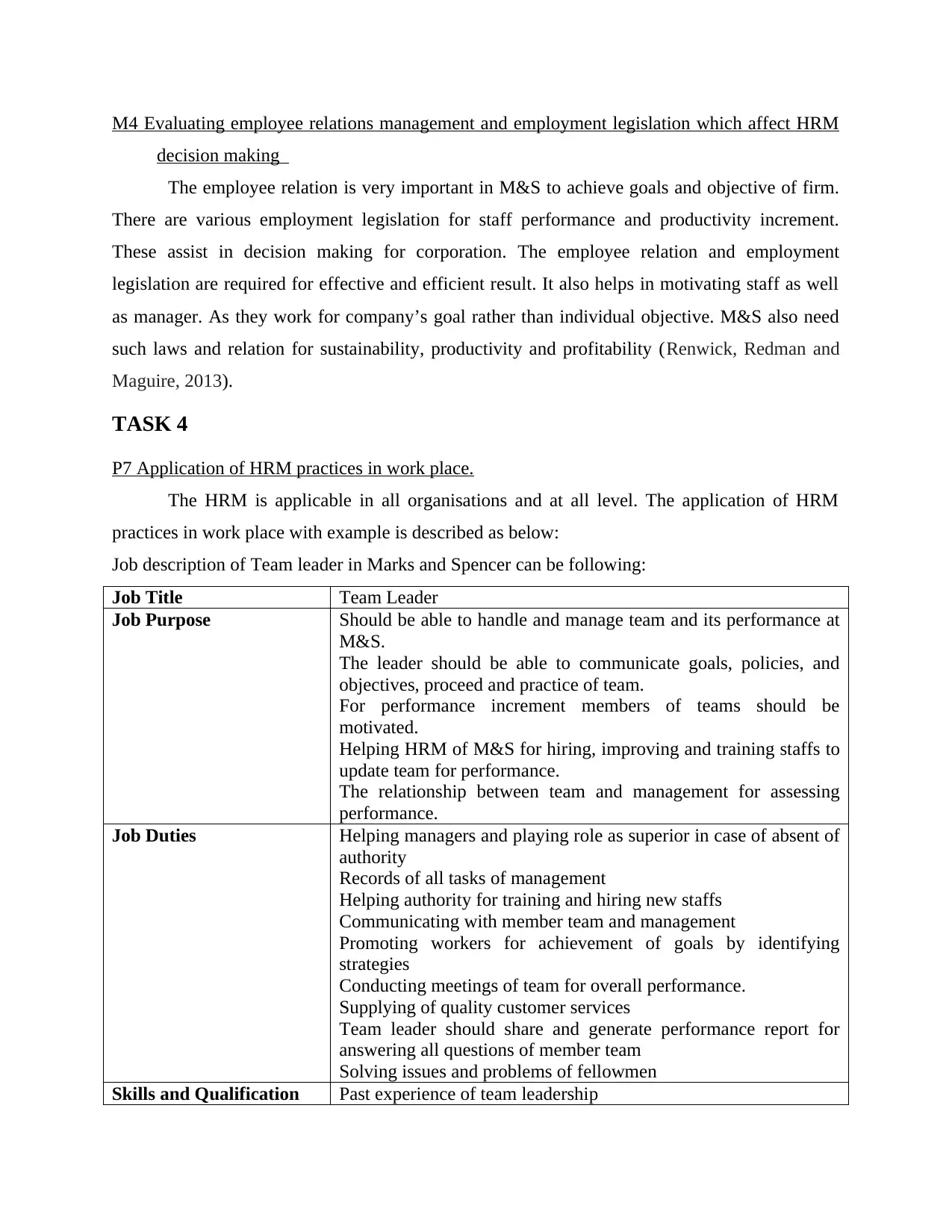
M4 Evaluating employee relations management and employment legislation which affect HRM
decision making
The employee relation is very important in M&S to achieve goals and objective of firm.
There are various employment legislation for staff performance and productivity increment.
These assist in decision making for corporation. The employee relation and employment
legislation are required for effective and efficient result. It also helps in motivating staff as well
as manager. As they work for company’s goal rather than individual objective. M&S also need
such laws and relation for sustainability, productivity and profitability (Renwick, Redman and
Maguire, 2013).
TASK 4
P7 Application of HRM practices in work place.
The HRM is applicable in all organisations and at all level. The application of HRM
practices in work place with example is described as below:
Job description of Team leader in Marks and Spencer can be following:
Job Title Team Leader
Job Purpose Should be able to handle and manage team and its performance at
M&S.
The leader should be able to communicate goals, policies, and
objectives, proceed and practice of team.
For performance increment members of teams should be
motivated.
Helping HRM of M&S for hiring, improving and training staffs to
update team for performance.
The relationship between team and management for assessing
performance.
Job Duties Helping managers and playing role as superior in case of absent of
authority
Records of all tasks of management
Helping authority for training and hiring new staffs
Communicating with member team and management
Promoting workers for achievement of goals by identifying
strategies
Conducting meetings of team for overall performance.
Supplying of quality customer services
Team leader should share and generate performance report for
answering all questions of member team
Solving issues and problems of fellowmen
Skills and Qualification Past experience of team leadership
decision making
The employee relation is very important in M&S to achieve goals and objective of firm.
There are various employment legislation for staff performance and productivity increment.
These assist in decision making for corporation. The employee relation and employment
legislation are required for effective and efficient result. It also helps in motivating staff as well
as manager. As they work for company’s goal rather than individual objective. M&S also need
such laws and relation for sustainability, productivity and profitability (Renwick, Redman and
Maguire, 2013).
TASK 4
P7 Application of HRM practices in work place.
The HRM is applicable in all organisations and at all level. The application of HRM
practices in work place with example is described as below:
Job description of Team leader in Marks and Spencer can be following:
Job Title Team Leader
Job Purpose Should be able to handle and manage team and its performance at
M&S.
The leader should be able to communicate goals, policies, and
objectives, proceed and practice of team.
For performance increment members of teams should be
motivated.
Helping HRM of M&S for hiring, improving and training staffs to
update team for performance.
The relationship between team and management for assessing
performance.
Job Duties Helping managers and playing role as superior in case of absent of
authority
Records of all tasks of management
Helping authority for training and hiring new staffs
Communicating with member team and management
Promoting workers for achievement of goals by identifying
strategies
Conducting meetings of team for overall performance.
Supplying of quality customer services
Team leader should share and generate performance report for
answering all questions of member team
Solving issues and problems of fellowmen
Skills and Qualification Past experience of team leadership
⊘ This is a preview!⊘
Do you want full access?
Subscribe today to unlock all pages.

Trusted by 1+ million students worldwide
1 out of 17
Related Documents
Your All-in-One AI-Powered Toolkit for Academic Success.
+13062052269
info@desklib.com
Available 24*7 on WhatsApp / Email
![[object Object]](/_next/static/media/star-bottom.7253800d.svg)
Unlock your academic potential
Copyright © 2020–2025 A2Z Services. All Rights Reserved. Developed and managed by ZUCOL.





